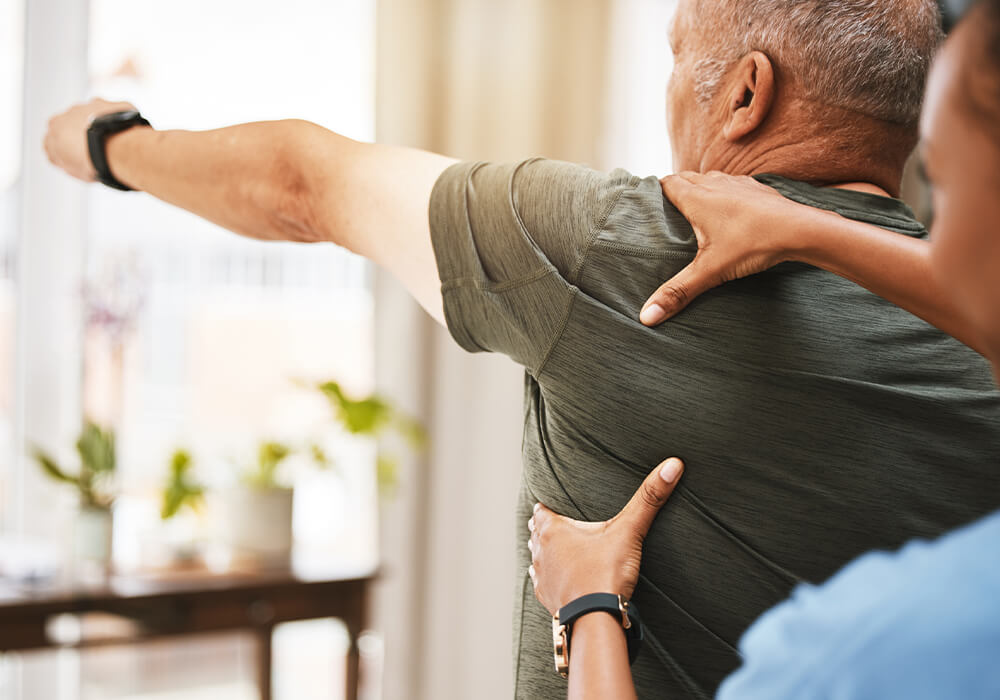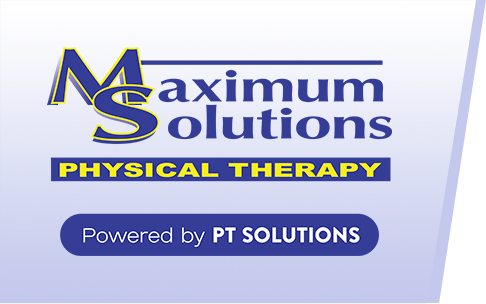Rehabilitation After Joint Replacement Surgery: What to Expect and How to Prepare
Undergoing joint replacement surgery, whether for the hip, knee, or shoulder, marks a significant step toward improved mobility and a better quality of life. The surgery is vital, but the journey doesn’t end there; rehabilitation is crucial in ensuring the procedure’s success and the patient’s long-term well-being. At Maximum Solutions Physical Therapy, we understand the importance of informed preparation and dedicated rehabilitation. Here’s what you can expect during the rehabilitation process after joint replacement surgery and tips on preparing for it.

Joint Replacement Surgeries
Joint replacement surgery, also known as arthroplasty, involves the removal of a damaged joint and its replacement with a prosthetic device made of metal, plastic, or ceramic materials. These prosthetics are designed to replicate the movement of a natural, healthy joint. While the specifics can vary depending on the joint being replaced, here’s a general overview of what the surgery looks like:
Before Surgery
- Pre-operative Assessment: Patients undergo a comprehensive evaluation, including a medical history review, physical examination, and imaging tests (like X-rays or MRIs) to determine the extent of joint damage and plan the surgery.
- Preparation: Patients may be advised on pre-surgical exercises, medication adjustments, and fasting requirements.
During Surgery
- Anesthesia: The procedure is performed under general or regional anesthesia to ensure the patient is comfortable and pain-free.
- Incision: The surgeon makes an incision over the affected joint to access the damaged bone and cartilage.
- Removal of Damaged Joint: The damaged portions of the joint are precisely removed, preserving as much healthy bone and tissue as possible.
- Prosthesis Placement: The prosthetic joint components are then positioned and secured. In knee replacements, for example, both the end of the thigh bone (femur) and the top of the shin bone (tibia) are capped with prosthetic surfaces. In hip replacements, a prosthetic ball (to replace the femoral head) is placed into a socket component (to replace the acetabulum).
- Closure: The incision is closed with sutures or staples, and a dressing is applied to the wound.
After Surgery
- Immediate Post-Operative Care: Patients are moved to a recovery area where vital signs are monitored as the anesthesia wears off. Pain management begins immediately.
- Hospital Stay: The length of the hospital stay can vary, typically ranging from a few days to a week, during which the patient begins initial rehabilitation exercises under the guidance of a physical therapist.
- Rehabilitation: A comprehensive rehabilitation program is critical for recovery. This includes physical therapy to strengthen the muscles around the new joint, improve flexibility, and promote mobility.
- Follow-Up: The surgeon schedules regular follow-up appointments to monitor the healing process and the function of the prosthetic joint.
Types of Joint Replacement Surgeries
- Knee Replacement (Total or Partial): Replaces damaged knee joint parts.
- Hip Replacement: Involves replacing both the ball (femoral head) and socket (acetabulum) of the hip joint.
- Shoulder Replacement: This can involve replacing just the ball (humeral head) or both the ball and socket (glenoid).
Joint replacement surgeries have evolved significantly, with advancements in surgical techniques, prosthetic design, and post-operative care considerably improving outcomes. These surgeries successfully relieve pain, restore mobility, and improve the quality of life for individuals with severe joint damage.
The Importance of Rehabilitation
Post-surgical rehabilitation is a cornerstone of the recovery process after joint replacement surgery, playing a critical role in the immediate aftermath and ensuring the long-term success and functionality of the joint replacement. This multidimensional process is designed to:
- Alleviate Post-Operative Symptoms
- Restore Essential Mobility
- Build Supportive Strength
- Reintegrate Into Daily Life
- Ensure Joint Longevity
Post-Surgical Rehabilitation
1. Early Post-Surgical Phase: During the first days following surgery, rehabilitation focuses on foundational recovery efforts.
- Pain and Swelling Management: Initial exercises are gentle and aimed at mitigating pain and reducing swelling. Techniques may include ice, compression, and elevation.
- Joint Protection: Patients learn how to protect the joint through proper movement techniques and assistive devices as needed.
- Circulation and Mobilization: Early mobilization exercises help enhance circulation, vital for healing, and start regaining movement in the joint.
2. Intermediate Phase: As patients move past the initial recovery stage, rehabilitation becomes more dynamic.
- Intensified Exercise Regimen: The complexity and intensity of exercises increase, focusing on building the strength, flexibility, and endurance necessary for everyday activities.
- Functional Training: Patients engage in exercises that simulate daily tasks under the guidance of a physical therapist, ensuring movements are performed safely and efficiently.
- Continuous Evaluation: Progress is regularly assessed to adjust the rehabilitation plan as needed, ensuring optimal recovery.
3. Advanced Phase: In the final stretch of rehabilitation, the emphasis shifts to full reintegration and optimization.
- Return to Demanding Activities: Exercises and training during this phase prepare patients to return to sports, work, and other demanding activities.
- Safety and Prevention: A significant focus is on educating patients on how to use their new joint safely, recognizing limitations, and implementing strategies to prevent injuries.
- Function Optimization: The goal is to ensure that the new joint performs optimally, allowing patients to enjoy a higher quality of life with improved physical capabilities.
Rehabilitation after joint replacement surgery requires patience, dedication, and guidance. At Maximum Solutions Physical Therapy, we are committed to providing personalized, comprehensive care to support each patient through their recovery, helping them to achieve the best possible outcome and a swift return to the activities they love.
Enhancing the Recovery Journey
Rehabilitation after joint replacement surgery requires thoughtful physical, mental, and environmental preparation. Here are several tips to ensure a smoother rehabilitation process and the best possible outcomes.
Before Surgery
- Educate Yourself: Dive deeper into the specifics of the rehabilitation process, familiarizing yourself with the stages of recovery and the types of exercises involved. Knowledge is power—it can significantly lessen pre-surgery apprehensions and mentally equip you for the journey ahead.
- Physical Preparation (“Pre-hab”): Participating in pre-surgery exercises prescribed by a physical therapist can be immensely beneficial. These “pre-hab” routines strengthen the muscles around your joint, enhancing your body’s readiness for surgery and post-operative recovery. Stronger muscles pre-surgery can lead to a quicker regain of function post-surgery.
- Home Preparation: A well-prepared living environment can significantly improve your post-surgery recovery. Adjust your living space to ensure easy access to frequently used items, reducing the risk of falls. Safety modifications include installing grab bars in bathrooms, securing loose rugs, and guaranteeing a clutter-free path in your home.
After Surgery
- Follow Professional Advice: Your physical therapist’s guidance suits your condition and recovery goals. Adherence to these recommendations is a cornerstone of successful rehabilitation. Whether it’s about how much weight to put on your new joint or how to perform an exercise correctly, following professional advice is critical.
- Stay Active: Active participation in your prescribed rehabilitation exercises is crucial. While it’s essential to respect the healing process and not overdo it, staying engaged in your recovery can help maintain muscle strength and joint flexibility. As your recovery progresses, gradually increase your activities as your healthcare team guides.
- Nutrition and Hydration: Optimal healing requires proper nutrition and hydration. A diet rich in vitamins, minerals, and proteins supports tissue repair and overall health. Adequate hydration is also essential for recovery, aiding joint lubrication and nutrient transport.
Emotional and Mental Preparation
- Build a Support System: The support of friends, family, and peer groups can offer motivational boosts and emotional comfort throughout your recovery. Sharing experiences and progress with others who understand can provide valuable encouragement.
- Set Goals: Having clear, achievable goals for your rehabilitation can motivate you. Discuss these goals with your physical therapist, who can help tailor your rehabilitation plan to align with your aspirations, whether returning to a favorite hobby or achieving a certain level of physical activity.
Long-term Success with Maximum Solutions
Successful rehabilitation after joint replacement surgery encompasses physical, emotional, and environmental preparation. At Maximum Solutions Physical Therapy, we’re committed to guiding you through each step of this journey, ensuring you’re well-equipped for immediate recovery and the long-term maintenance of your joint health. With the proper preparation and support, you can look forward to regaining mobility and enjoying an active, fulfilling life post-surgery.

